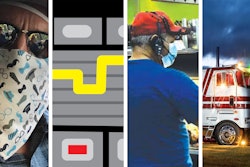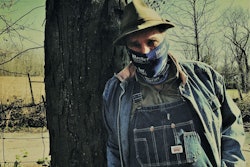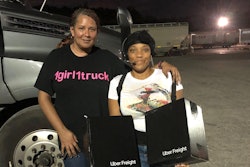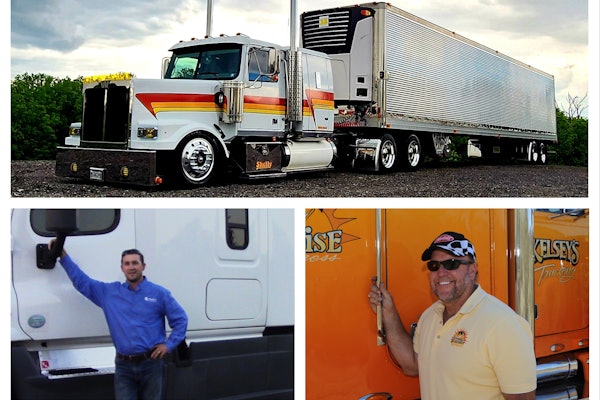In case you missed it — a personal piece from my colleague David Hollis at TruckersNews.com detailed the experience last week of Warren Potter, company driver of Ottumwa, Iowa, at a load location in California where a county mandate had been thrust into place for workers at essential businesses to wear masks on-site at work with others. Told about the new mandate last week by personnel of the facility he’d arrived at in the city of Colton (due east of Ontario), Potter was able to MacGyver a solution by cutting the top out of a knit hat, turning it upside down, then pulling it down over his head so that it covered his mouth and nose, like this:
 As Potter noted in an email to Hollis and all of us here at Overdrive, too, this solution was good enough for the shipper. “It worked,” Potter says, “but at 80 degrees out it was miserable.”
As Potter noted in an email to Hollis and all of us here at Overdrive, too, this solution was good enough for the shipper. “It worked,” Potter says, “but at 80 degrees out it was miserable.”More comfortable solutions — the tried and true bandanna, for instance, folded over a few times and tied around the back of the head — have been used by many, I know. After the Centers for Disease Control a few weeks back recommended all of us to wear face coverings in public places where distancing is difficult to maintain, I took to visits to the grocery store and elsewhere with a variation on the bandanna theme, with the knot tied high on the back of my head and secured with my favorite Bell Trucking ballcap (tip of that hat over to Scott Durant — been a while!), for a little more snug fit, as such:
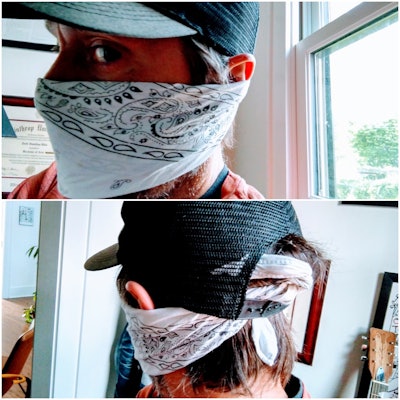 Yeah, I know, I looked like I was ready to rob the place.
Yeah, I know, I looked like I was ready to rob the place.Dr. Matt Maune last Thursday detailed a variety of other, better options for DIY and production masks via the webinar hosted by TBS Factoring Service last Thursday with the Truck Boss Show. Maune’s talk near the beginning runs through key considerations and options, from basic surgical masks to those higher-quality N95 masks in demand for our health-care workers and the, er, more creative solutions that are popping up everywhere when it comes to cloth masks.

 Our own Paul Marhoefer was using a more proper mask at truck stops and shipper/receiver sites hauling when it outlived its useful life, at least without some necessary cleaning/rehabilitation — so “we bought some baby bibs in Mississippi,” he says, here pictured.
Our own Paul Marhoefer was using a more proper mask at truck stops and shipper/receiver sites hauling when it outlived its useful life, at least without some necessary cleaning/rehabilitation — so “we bought some baby bibs in Mississippi,” he says, here pictured.Key consideration, as Dr. Maune emphasized in the TBS webinar, and as CDC notes, too: a simple cloth facial covering really isn’t a substitute for the efficacy of physical distance when it comes to preventing contagion, though the defense such a covering presents will be an effective barrier for large droplets from coughs/sneezes, from a spitty talker, etc. Geerally, too, the recommendation to wear them is mostly intended to keep the wearer from projecting such things elsewhere …
Some cloth masks do allow for the insertion of filter media that can be effective for airborne microbial particles, in lieu of a more proper mask. Catch a replay of Maune’s talk via this link, and for CDC diagrams on pretty simple no-sew options with ear securement using an old t-shirt or a bandanna, follow this link.
As some states begin to relax statewide stay-home mandates, distancing will remain recommended, and expected to continue mandated at the local level in areas where COVID-19 outbreaks are more widespread, as is the general case where I live in Tennessee. Various forms of face-covering mandates themselves are in place in several states — New York, New Jersey, Pennsylvania, Connecticut, Maryland (for public transit riders), Rhode Island — and in local jurisdictions, as Potter found out. (I heard my city’s mayor this morning talking about a potential new ordinance to require masks on construction sites, for what that’s worth.)
In short, this is going to be with us for a long time, I’m afraid. While mask requirements at facilities will surely vary, best to be prepared if you need it.
As Hollis wrote in his story, too, ask around your local community and you’re sure to find sewing circles and others distributing coverings, if not the very fleet you’re leased to or even that shipper who’s requiring a mask. If as happened with the Corsair distillery in Nashville here, a purveyor of liquor “can make hand sanitizer,” Hollis wrote, he guessed truckers “and companies that support it will figure out how to ensure every driver has what they need while on the road.”
I hope that’s the case, too.
Now, what’s your mask solution? Pictures? Let’s take over the Reader Rigs Gallery for a day with mask shots, maybe? You can upload a photo and a description here.




